Survival In The Saddle • Part 4
In this episode of the Survival in the Saddle series we’re going to be discussing some hazards to motorcycle riders that some bikers may never have given much thought to. If you were to poll 50 different motorcyclists and ask them what they thought are the greatest threats they face on the road you would probably get 50 different responses.
Distracted automobile drivers. Oil spills on the roadway. Intersections. Riding in the rain or other inclement weather. Steel plates and grooved, milled pavement in construction zones. Grass clippings and tar snakes. Potholes and other serious road surface defects. Wildlife and unrestrained domestic animals. The list goes on and on and on.
Things that are a mere inconvenience to automobile drivers can be extremely dangerous or even deadly to motorcycle operators. Parked cars, and navigating parking areas are a couple of the the scenarios that fall under this category. They deserve to be discussed and the information presented here could save you from dangerous encounters.
Yes…Even Parked Cars Are Hazards To Motorcycle Riders
Many motorcyclists are well-aware of the things we’re about to discuss here. Some have forgotten over time these important lessons learned in the past. Some may never have given them any thought. All bikers would do well to absorb the information being presented here. Under the heading of “a picture is worth 1,000 words” this post will be very image-intensive.
In the diagram below we demonstrate where you should position your motorcycle as you navigate past a row of parked cars. It doesn’t matter if those cars are parallel parked or diagonally parked. Dangers exists in both cases. You should assume a position in the left track or center track of the lane of travel. Do not ride in the right track of the lane, closest to the parked cars.
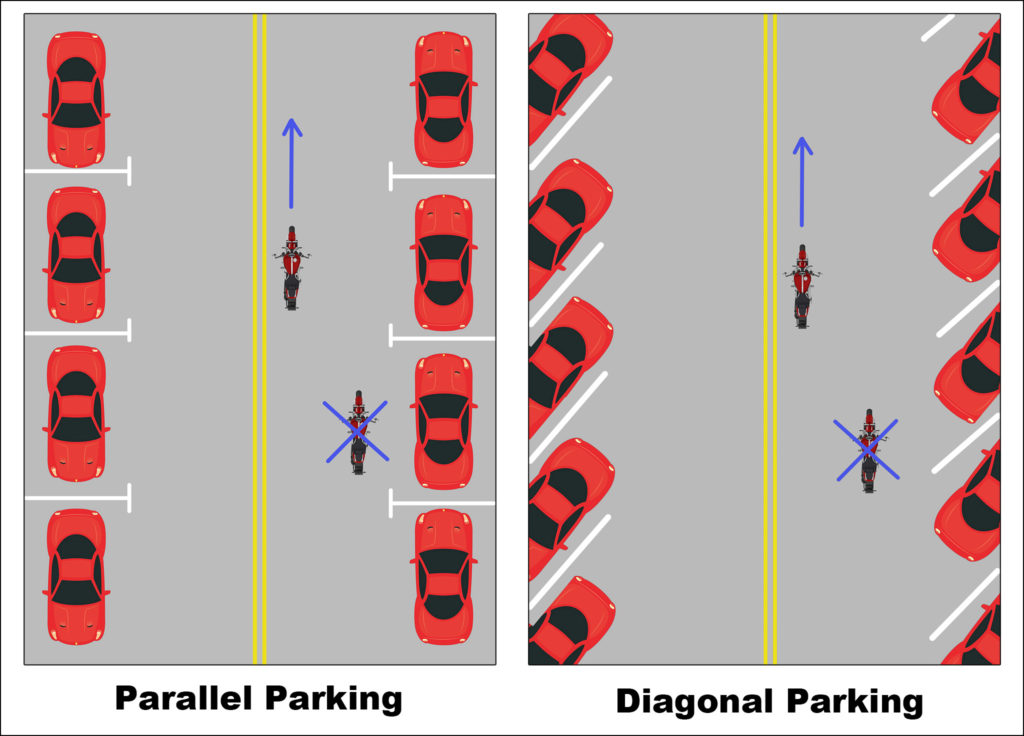
Beware of Cars Leaving Their Parking Spots
The first of the obvious hazards to motorcycle riders created by parked cars are those cars that may be leaving their parking spots. Parallel parked cars are usually easier to spot. Don’t rely on the departing car to be using their directional indicator to signal their intention. We all know that most drivers have completely forgotten that those important safety devices even exist.
There are some good clues available that could indicate the imminent departure of a parallel parked car. Look for illuminated brake lights. The driver’s foot will be on the brake (at the very least) to put their car in gear to leave the parking spot. Look at the front wheels of parked cars. If you see a parallel parked car with its front wheels turned sharply to the left, it could be about to pull out of its spot.
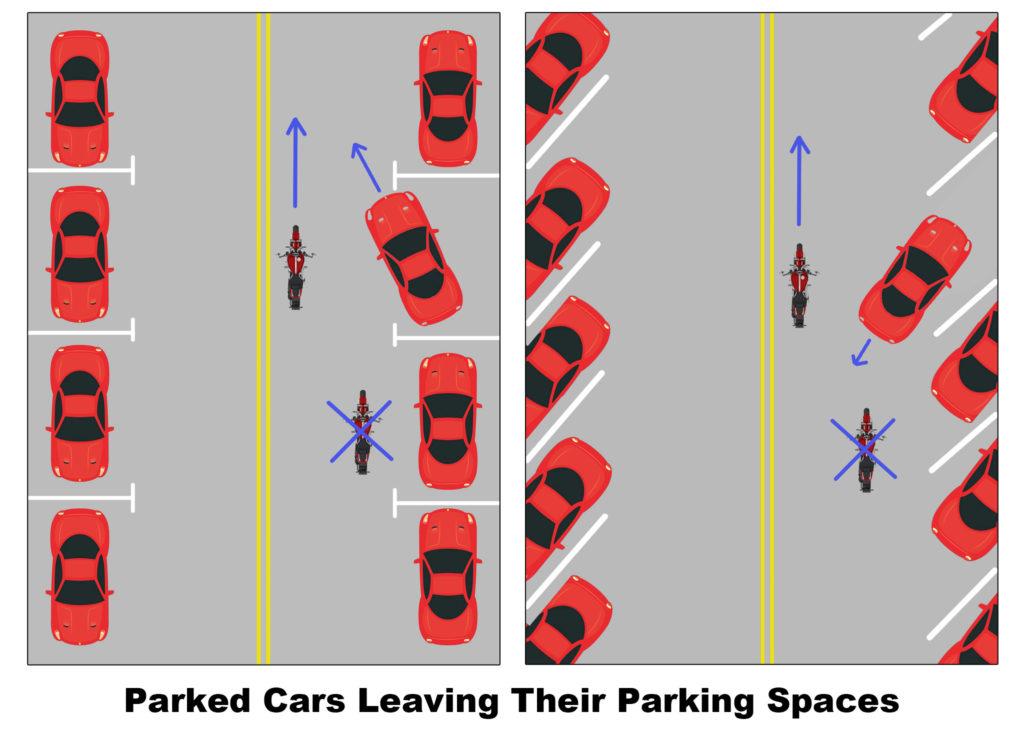
Over decades of riding I’d developed the habit of actually looking into the parked cars I was passing. A driver’s head behind the steering wheel was always a good clue that the car might be exiting its parking spot at any moment. It’s still a good thing to try to do, but the proliferation of dark tinted windows has made this a less effective tactic these days. You simply can’t see into most cars these days.
Beware of Cars Staying In Their Parking Spots
Cars abruptly leaving their parallel parking spots aren’t the only hazards to motorcycle riders. The stationary ones can be a problem also. Consider the series of photographs below. The illuminated brake lights on the Jeep parked on the right is a clear indication that there is someone behind the wheel. Pay attention.
Your first thought might be that the driver will soon leave the spot after you pass by. Don’t assume anything! That driver might actually be preparing to leave the vehicle. That driver’s door could swing open in front of you in an instant! Again…assume a position in your travel lane away from the parallel parked cars on the right hand side.
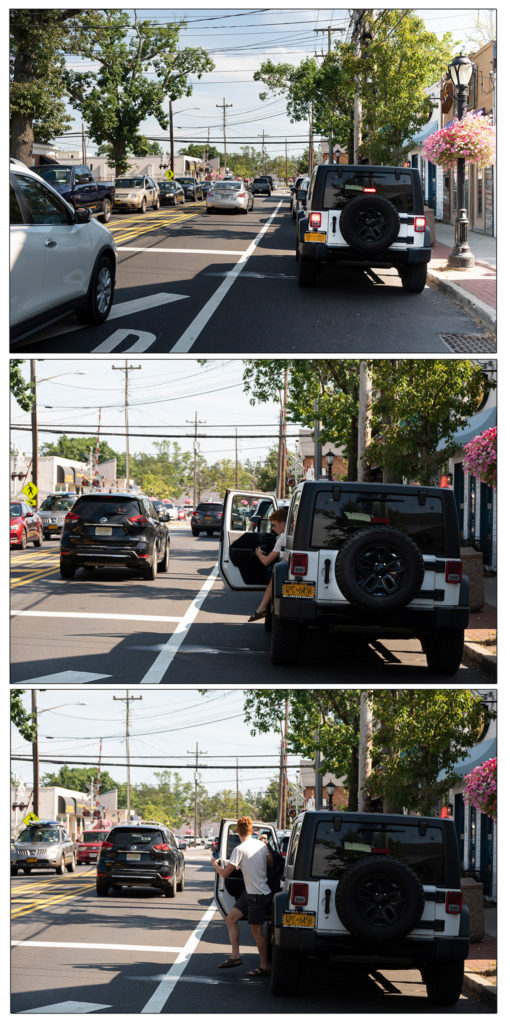
A Different Angle on This Topic
Diagonally parked cars present their own unique hazards to motorcycle riders. These hazards revolve around visibility…in particular the motorcyclist’s view being impaired; especially by high-profile vehicles such as vans and larger SUVs. In a previous post we suggested that motorcycle riders should be looking…really looking…at least 8-10 seconds ahead of where they currently are. When navigating past parked cars you need to also be acutely aware of what is happening right in front of you. Like two seconds in front of you.
In the photographs below the observant motorcyclist sees that a pedestrian has just crossed from the right side of the road to the left. A truly competent motorcyclist is looking further ahead and spots a pedestrian ahead crossing from the left side of the road to the right. They also see a large delivery truck ahead on the right which could present a problem when they get there.
The expert motorcyclist is also looking directly in front of them. They see that large white SUV parked on the right. A parked car or pedestrian could emerge from behind that SUV in an instant! Be ready for that. The expert motorcyclist has slowed down, covered their brakes and is prepared to make a panic stop if necessary.
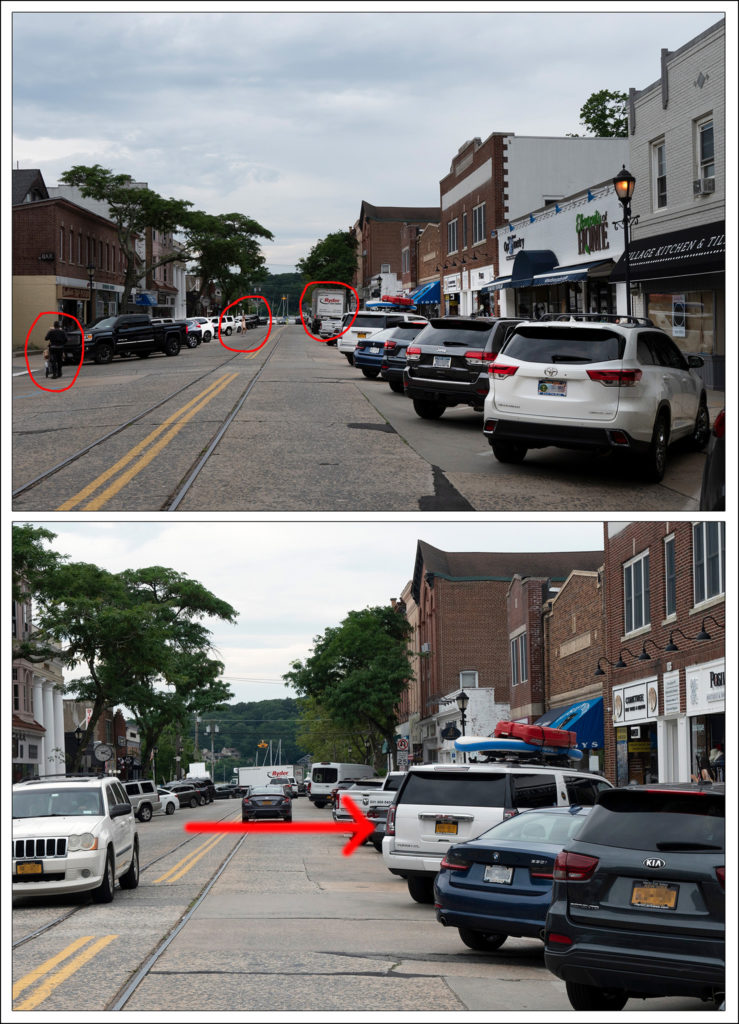
Choose Your Best Vantage Point
Again we stress that taking a position in the center to left track of your travel lane is the best tactic. The choice is yours and you have nobody but yourself to blame if your visibility becomes compromised by not following this advice.
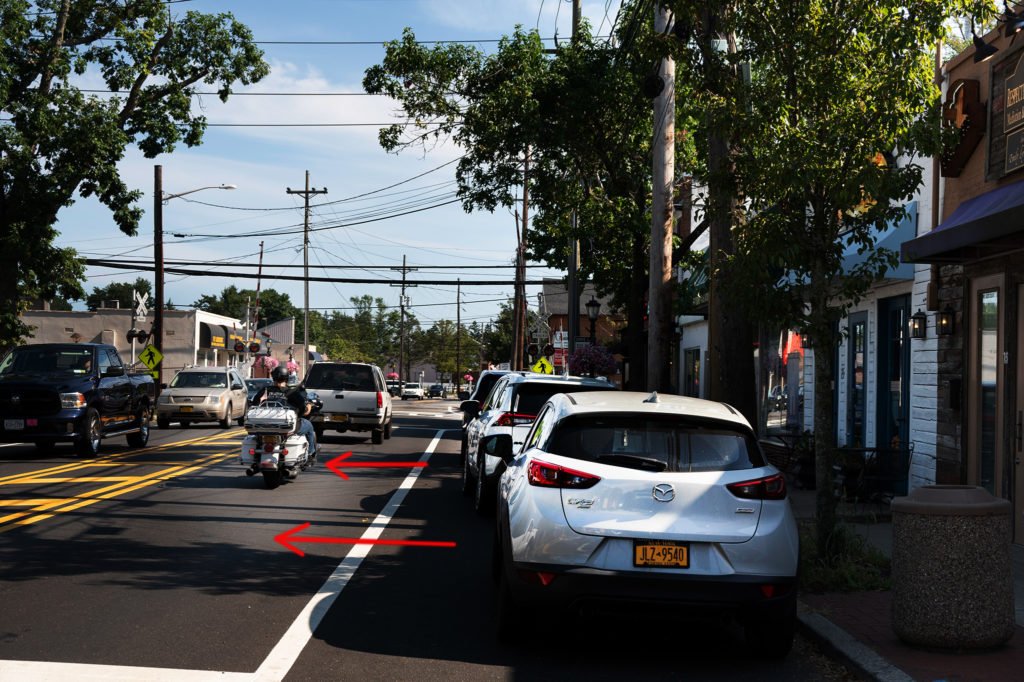
A motorcycle traveling in the center track of the traffic lane leaving ample room from the parallel parked cars on the right
In the photographs below you’ll see a perfect example of what we’re talking about. In the top image (the view from the right track of the travel lane) the motorcyclist can see only the large white SUV. In the bottom image (where the motorcyclist has moved to the center track of its travel lane) the parked car next to the SUV has become visible to the motorcycle operator. Move over! A foot or two of position adjustment is the difference between seeing, or being oblivious to, the potential hazard lurking behind the parked high profile vehicle.
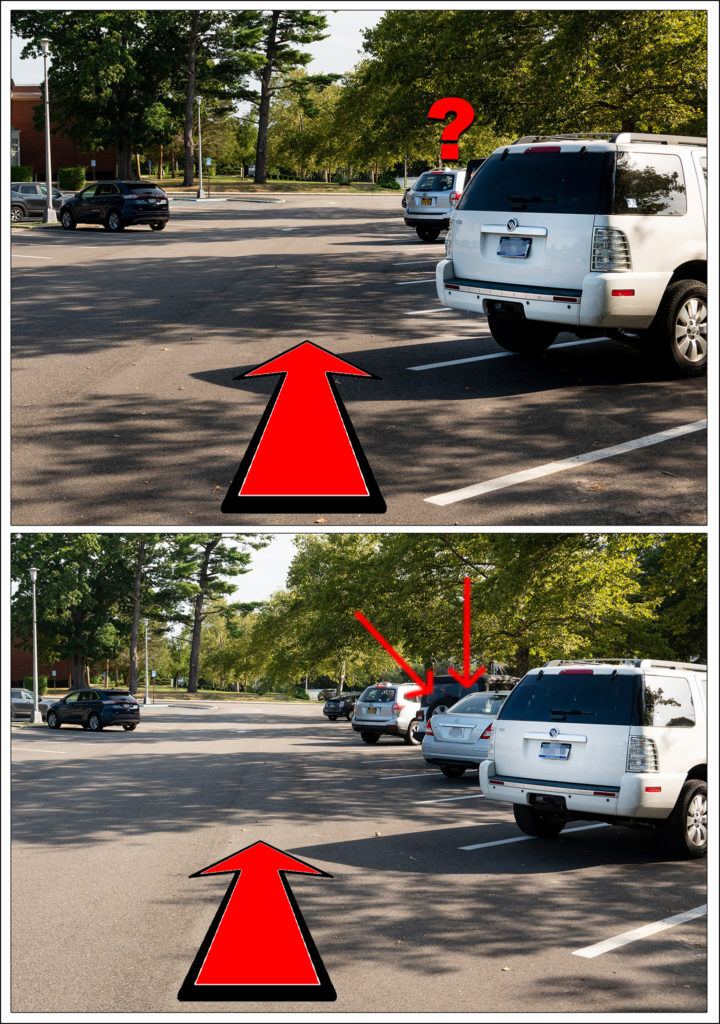
Surprise Delivery
In these days of online shopping we all get excited when we see the Amazon or UPS driver pull up in front of the house. Hooray! That cool new gadget I ordered for the bike has arrived. Those high profile delivery vehicles are bringing more than goodies to your neighborhood. They could be bringing danger.
The photographs below give a perfect picture of what we’re talking about. The delivery truck is parked on the side of the road with its hazard flashers on. You should be fairly confident that this professional driver is not going to suddenly pull out in front of you. But the second picture reveals the real hazard here. There is a car in front of that delivery truck, invisible to you as you approach, which could potentially pull out suddenly in front of you. You can’t see that car as you approach…and they can’t see you! Be alert!
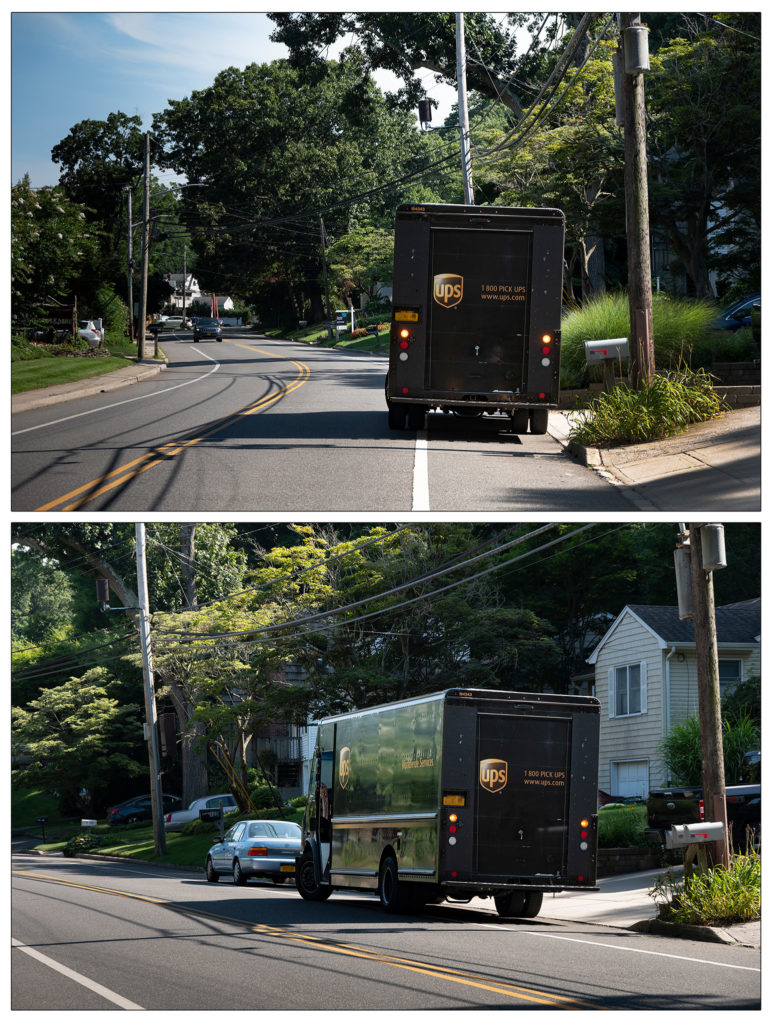
Safely Navigating Parking Lots
We have some good news and we have some bad news. First the good news. When moving through a public parking lot you will be traveling at a much slower rate of speed than you would be out on the road. The bad news: A whole new set of hazards to motorcycle riders present themselves within the confines of parking lots.
The most obvious one is illustrated in the photograph below. Distracted pedestrians. Distraction from smartphones (Dumbphones?) is not the exclusive domain of people behind the steering wheel. Even pedestrians casually walking through public parking areas are engrossed in their handheld devices and oblivious to what is going on around them. Keep your eyes out for them. They’re not looking for you.
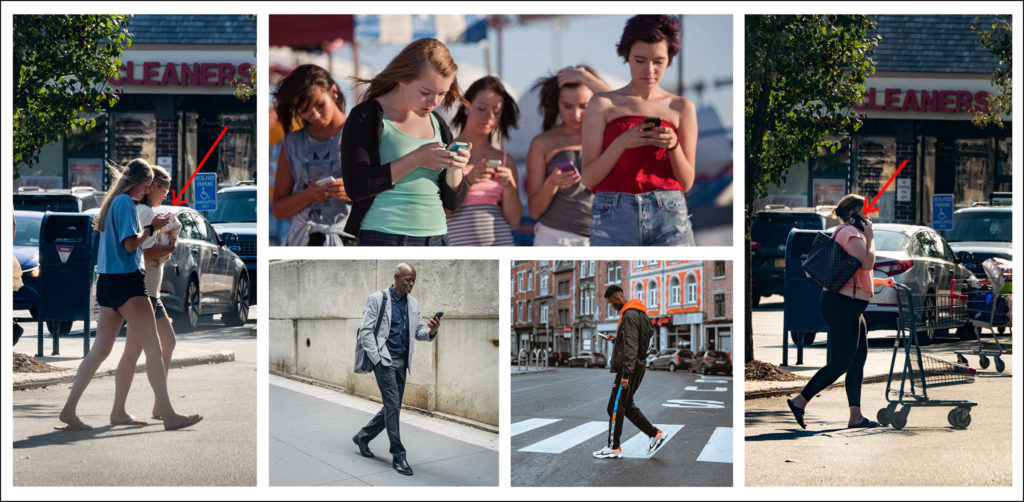
Look For Clues…and The Clueless
You can sometimes spot an impending encounter with a pedestrian ahead of time. In the photograph below I show one of the things I’m always on the lookout for. Like searching for “Where’s Waldo” I look for heads between parked cars. Sometimes those heads are just getting in or out of their parked cars, but often they are walking between parked cars and are about to step out in front of you. Be alert.
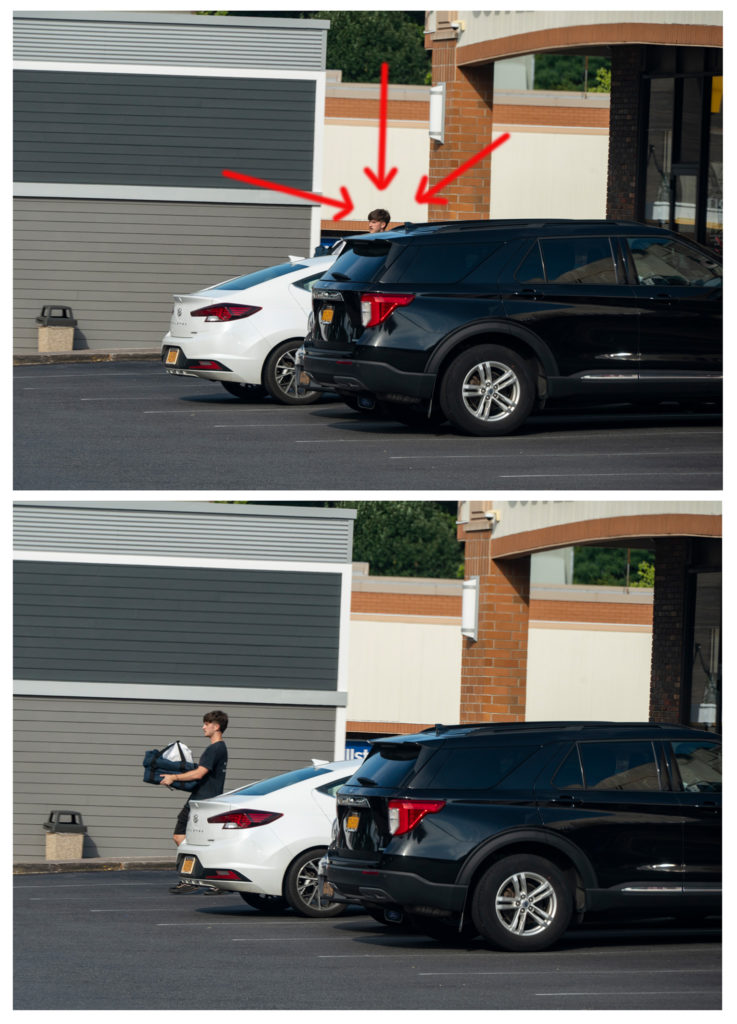
I’m also very wary of those people who plant their cars in no parking zones while they “just run inside quickly” to pick up something at the store. Not only have these rude folks already displayed their willingness to break the rules, they are likely to be leaving those illegal parking spots in a real hurry. They’re very busy, you know? Watch out for them.
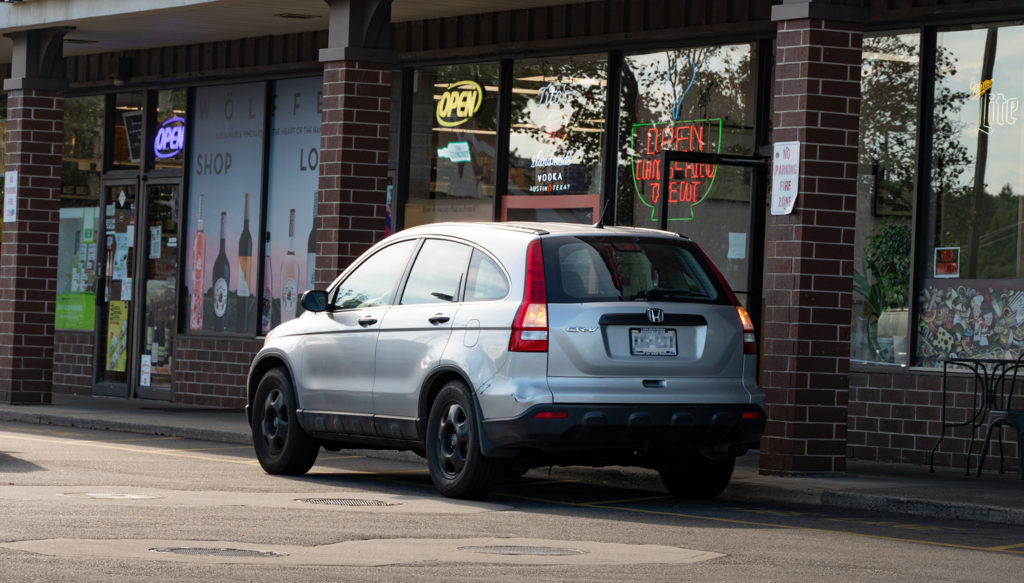
Caution: Children At Play
I can’t stress this one enough. This one is personal.

Not all children safely and obediently traverse parking lots under the guidance and protection of diligent parents. Some of them are quite the opposite…out of control. Always be on the lookout for children. They can appear from between parked cars, and in front of your bike, in an instant. Be ready for it to happen. Sooner or later it will.
It happened to me some 25 years ago. I’m happy to report that the child was not hit. I’m embarrassed to report that it caught me so off guard that I nearly dumped my 900 Lb. touring bike on the ground. The bike never hit the pavement but my awkward, improperly executed, evasive maneuver left me with two broken bones in my foot. I spent the next eight weeks of glorious late spring riding weather, on crutches and in a cast, thinking about how I could have handled the situation differently.
Back To The Basics
A couple of things come to mind. When you’re operating your motorcycle within the confines of a parking lot at slow speed you need to maintain perfect control of the machine. You’ll most likely be executing a few low speed, tight turns. Your clutch should be held in the friction zone and you should maintain perfect throttle control. This is no time to be pulling in the clutch and revving your motor’s loud pipes to announce your presence. You’re putting yourself, and potentially others, at risk by making that decision to give up optimal control of your motorcycle.
Practice, practice, practice. You never know when you might be faced with an emergency situation…even a low speed one. Practice your low speed panic stops and swerving maneuvers so that they become instinctive when you need them. After more than three decades of riding I recently repeated the MSF (Motorcycle Safety Foundation) low speed skills course. It’s amazing the bad habits you can fall into after riding relatively trouble-free for a long period of time.
I spend a quick five minutes in an open parking lot every week now. I’ve got my low speed skills pretty well dialed in and I want to keep them there. Practice is the only way. When I do negotiate parking lots these days I force myself to do so in the most perfect manner possible; even if no apparent hazards exist. I want my performance to be perfect when a dangerous situation does present itself.
Conclusion
We hope you have enjoyed this feature on some of these most basic hazards to motorcycle riders that often go forgotten. It is our mission to help motorcyclists of all levels become better at this wonderful chosen pursuit of ours. If we prevent one accident…if we save one life…it has been worth all the effort we put into this online resource. As always we welcome your comments below and encourage you to subscribe to Roadcraft USA for updates when new features hit the blog. Ride safe everyone!
Click Here to view an interactive visual index page where you can quickly browse through all of the great features that are published on the Roadcraft USA blog.

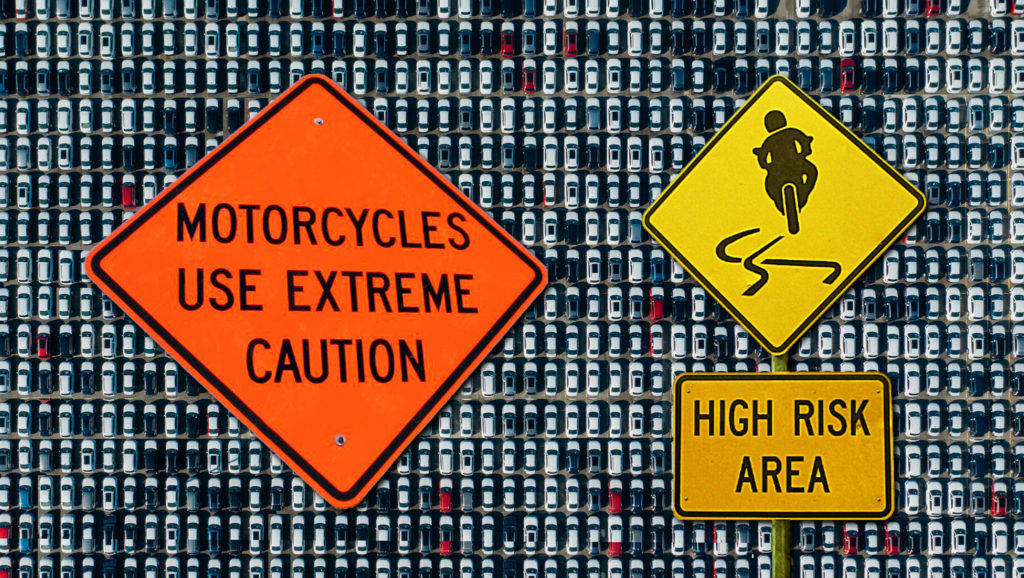
excellent review . I also pratice when I am in an empty area of a lot. Swerving, braking & having total control is the key. Slow down & beep – beep to get noticed They never ever see you & riding on 2 wheels will ALWAYS lose.
Practice makes perfect. You want your emergency maneuvers to be practiced and instinctive when you need to employ them. Thanks for commenting, Dave.